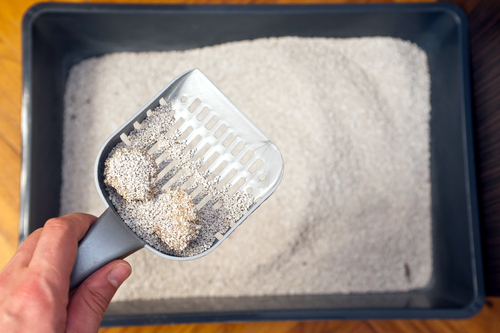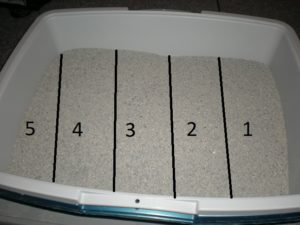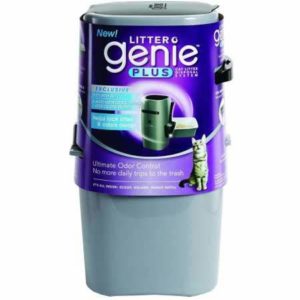
If you are a new cat owner and need to know how to properly clean your cat litter box know that there is not one unique way. An important key is making this process a breeze so you will do this task more often. Keeping the litter box clean avoids health issues with your cat and in your family.
5 Tips to daily clean the litter box
The following tips when scooping the litter box daily help you to get a clean, odor-free, and easy-to-scoop cat litter box. When cleaning the cat litter box remember to wear rubber gloves and a mask, to make this process more hygienic.
1. Make it easy to clean the litter box
To clean the litter box properly, you need to use the right tools to get the best results with less effort.
- The litter box needs to have at least 8 inches of extra space compared with your cat’s body length (not including the tail). This helps to prevent feces or urine from going onto the walls or edges.
- Use a high-sided or enclosed litter box to prevent cat waste from going onto the litter mat.
- Use a litter box with rounded corners that make it easier to scoop those areas. Also, get a litter box with anti-stick coating inside (learn more tricks to avoid litter from sticking to the box).
- Put about 2 inches of dust-free clumping cat litter. This is deep enough to protect the bottom of the litter tray.
- Use a metal scoop with rounded edges. The scoop must have medium-sized holes, not too large or too small; large holes allow dirty litter to go through and small holes don’t allow the litter to be sifted easily.
- To store the scoop conveniently get a scoop holder such as the “CatGuru” or “Scoopy” that looks cute and keeps the scoop hygienically away from the box or floors.
2. How to scoop
Having a metal, rounded-edged scoop allows you to firmly scoop the box. Plastic scoops sometimes bend a little making it hard to firmly scrape the bottom. The most efficient way to scoop the litter box is by following imaginary sections across the walls of the box, so you don’t miss anything (see the image below). Make sure you reach the bottom and remove all traces of waste.

If you want to make sure there is no cat waste stuck in the litter box you can tilt the box at an angle of approximately 45 degrees to let most of the litter get out of the way and see possible clumps left. Scrape everything that is stuck inside the litter box. Remember that the better you clean the litter box, the more odor control you can achieve.
3. Disposal
There are special cat waste disposal systems, such as the Litter Genie or PetFusion Portable that keep everything sealed inside, avoiding odors. These systems allow you to keep the disposal container next to the litter box, making it very convenient and with no odors. These disposal containers come with a certain amount of liners and then you have to purchase extra liners. Another option is using odor-sealing cat waste disposal plastic bags, such as the BOS. These bags are unscented and can be dumped in any trash container inside the house. You can find sizes from XXS to XL to fit your needs. For a single cat, using the XXS it’s a good choice, you pay only $16 for 200 bags.

4. Wipe cleaning the sides
Once you are done scooping the litter box it’s a good idea to wipe clean all the exposed sides and surfaces of the box that are usually dirty. Use non-toxic pet-friendly wipes and also make sure to use gloves in this process. You can use scrubbing wipes to clean the scoop as well.
5. Topping off
If the litter level is lower than the recommended 2 inches after scooping the litter box, you need to top it off with clean litter. It’s important to always keep the same amount of litter so cat urine won’t sit in large amounts on the bottom of the litter box. This creates bacteria formation inside the plastic that is almost impossible to remove. To make the job easy, keep a small lidded container full of clean litter to pour some in when needed.
5 Tips to deep clean the litter box
You need to deep clean the cat box every two weeks if you have a single cat and every week if you have multiple cats. Use gloves and a mask, especially if you are pregnant or have immune issues.
1. When emptying the litter box
Dump the mat out on top of the litter box before emptying it. Get a strong plastic bag and cover one end of the box with the bag. Tilt the box slowly making sure all the dirty litter goes inside the bag. Use wipes to clean the sides or bottom of the litter box. This step is necessary in case the box has some caught feces.
2. When washing the box
Use lukewarm water to wash the plastic litter box and wash it thoroughly using a soft bottle brush so it doesn’t scratch the surfaces. Ivory® soap is good for cleaning the litter box, or a paste with baking soda and water can be made. After cleaning, the container may be rinsed with a diluted bleach solution (one part bleach to 9 parts water).
Do not use pure chlorine, ammonia, or cleaners based on citrus fruit when doing so. Using any of them may be too strong for your cat and cause aversion to the litter box. Rinse thoroughly using cold water. Finally, make sure to dry the litter box leaving no humidity. The fastest way to dry it is with a paper towel making sure to get the corners where water accumulates.
3. Deodorizing the box
When it comes to litter box deodorizers, you have three basic options: baking soda, briquettes of charcoal, and filters. For baking soda, just sprinkle one or more teaspoons on the box until the litter is applied. Baking soda helps to absorb the smell and may help to absorb urine. The same applies to the briquettes and filters, only place them on the base of the container before putting the cat litter to reduce odor.
4. Removing odor enzymes from the litter box area
When deeply washing the litter box it’s a good idea to remove urine or feces odor enzymes from the litter mat. This will stop your cat from having another litter box accident. Use a good brand such as the Trinova Green Standard that is safe for your cat and Eco-friendly. Another urine destroyer is Nature’s Miracle which comes in a spray that sprays a foam that makes it easy to clean the mat or carpet.
5. Washing the scoop
Wipe clean the scoop first to remove excess waste. Then place the scoop in water with a bit of chlorine and leave it to soak for a few minutes. Then rinse the scoop thoroughly and dry it with a paper towel. Place the scoop in its holder.
Cleaning the cat litter box properly ensures odor control, it keeps germs at bay in your house and a very important thing, it makes your cat happy.
Leave a Reply